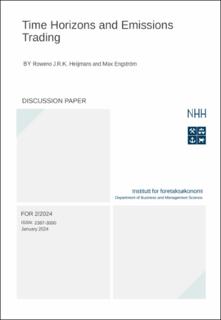| dc.description.abstract | We study dynamic cap-and-trade schemes in which a policy of adjustable allowance supply determines the cap on emissions. Focusing on two common supply policies, price and quantity mechanisms, we investigate how the duration of a cap-and-trade scheme affects equilibrium emissions under its cap. More precisely, we consider the reduction in equilibrium emissions realized by shortening the duration of the scheme. We present four main results. First, the reduction in emissions is positive and bounded from below under a price mechanism. Second, the reduction in emissions is bounded from above under a quantity mechanism. Third, these upper and lower bounds coincide when the price and quantity mechanism are similar. Fourth, we identify sufficient conditions for which the reduction in emissions is strictly negative under a quantity mechanism. We quantify our theoretical results for the European Union, the world’s largest cap-and-trade scheme to use a quantity mechanism; effects on cumulative EU emissions range from trivial to substantial. | en_US |
